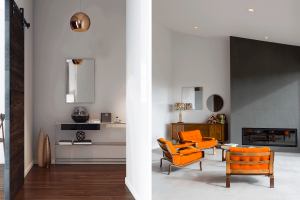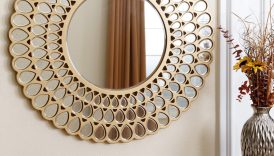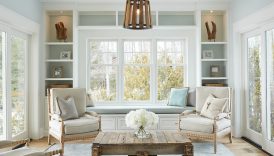Creating a Minimalist Modern Interior Design: Tips and Tricks

Introduction to Minimalist Modern Interior Design
Defining Minimalist Modern Style
Minimalist modern interior design emphasizes simplicity, functionality, and a sense of tranquility. This style strips away the clutter, focusing on essential elements that resonate with clean lines and open spaces. Think of a serene abode where every piece has purpose and every space invites calmness. Imagine stepping into a room bathed in natural light, with understated furniture that allows for breathing room. Key characteristics include:
- Creating a Minimalist Modern Interior Design: Tips and Tricks
- Introduction to Minimalist Modern Interior Design
- Defining Minimalist Modern Style
- Benefits of Minimalist Modern Design
- Choosing a Neutral Color Palette
- Understanding Color Psychology
- Implementing Monochromatic Schemes
- Decluttering and Simplifying Spaces
- Minimizing Furniture and Decor
- Organizing Storage Solutions
- Incorporating Natural Elements
- Introducing Plants and Greenery
- Using Natural Materials like Wood and Stone
- Embracing Clean Lines and Functional Furniture
- Selecting Sleek and Simple Pieces
- Focusing on Functionality and Comfort
- Lighting and Its Importance in Minimalist Design
- Maximizing Natural Light
- Choosing Modern and Minimalist Light Fixtures
- Adding Texture and Contrast for Visual Interest
- Playing with Textiles and Fabrics
- Experimenting with Different Textures and Finishes
- Personalizing Your Minimalist Space
- Displaying Thoughtful Artwork and Décor
- Infusing Your Personality in the Design
- Maintaining a Clutter-Free Environment in the Long Run
- Practicing Mindful Consumption Habits
- Regular Cleaning and Organization Strategies
- Neutral Color Palette: Soft whites, greys, and earth tones dominate.
- Space and Light: Open layouts and large windows enhance the airy feel.
- Functional Design: Every element must serve a purpose.
Benefits of Minimalist Modern Design
The allure of minimalist modern design extends beyond aesthetics; it also enhances lifestyle. Adopting this style can lead to:
- Reduced Stress: Fewer items create a more peaceful environment.
- Increased Focus: Simplified spaces promote better concentration and productivity.
- Less Maintenance: With fewer elements to manage, cleaning becomes a breeze, leaving more time for what truly matters.
By embracing the principles of minimalism, individuals often find a renewed sense of clarity in both their homes and lives.
Choosing a Neutral Color Palette
Understanding Color Psychology
When it comes to minimalist modern design, selecting a neutral color palette is crucial, as colors significantly influence mood and perception. For instance, warm shades like beige and soft taupe evoke comfort, while cool hues such as light grey can create calm and serenity. A delightful personal experience might be sitting in a sunlit room painted in pale tones, feeling energized yet relaxed, reminding us of how color affects our state of mind. Here’s a quick guide to color psychology:
- Neutral Colors: Promote peace and sophistication.
- Cool Colors: Instill calmness and tranquility.
- Warm Colors: Inspire warmth and comfort.
Implementing Monochromatic Schemes
One effective way to bring your neutral palette to life is through a monochromatic scheme. This involves using varying shades and tints of a single color, creating a visually cohesive look. Picture a living room adorned with different degrees of greys, from light to charcoal, complemented by soft furnishings in the same family. Benefits of a monochromatic approach include:
- Depth: Adds layers of interest without the chaos.
- Timelessness: Creates an elegant and sophisticated atmosphere.
- Ease of Coordination: Simplifies the selection process for decor and furnishings.
By thoughtfully choosing a neutral palette and employing monochromatic schemes, your space can embody the essence of minimalist modern design effortlessly.
Decluttering and Simplifying Spaces
Minimizing Furniture and Decor
To elevate your minimalist modern interior, decluttering is key—especially when it comes to furniture and decor. The idea is to keep only what is necessary and functional, allowing the space to breathe. Imagine your living room with just a sleek sofa and a simple coffee table instead of an overcrowded arrangement. This not only enhances visual appeal but makes the area feel larger. Here are some tips for minimizing furniture:
- Choose Multi-Functional Pieces: A sleek ottoman that doubles as storage can significantly reduce clutter.
- Limit Decorative Items: Focus on one or two statement pieces that express your style without overwhelming the space.
- Embrace Open Space: Allow for areas of nothingness to create a calming effect.
Organizing Storage Solutions
Once you’ve minimized your furniture, effective storage becomes vital. Concealed storage helps maintain that clean look while keeping essentials out of sight. Consider these solutions:
- Built-In Shelving: Maximizes vertical space without adding bulk.
- Hidden Compartments: Opt for beds or couches with storage drawers.
- Baskets and Boxes: Stylish containers can make organization effortless while adding a decorative touch.
By decluttering and implementing smart storage solutions, your minimalist modern space can truly shine with clarity and purpose.
Incorporating Natural Elements
Introducing Plants and Greenery
To enrich your minimalist modern design, adding natural elements is essential—especially greenery. Plants act as living art, bringing life and warmth into any space. A personal favorite is placing a tall fiddle leaf fig in the corner of a room; it draws the eye upwards and fosters a sense of nature indoors. Consider these ideas for incorporating plants:
- Mix Plant Heights: Combine tall plants with smaller ones to create visual interest.
- Minimalist Pots: Use simple, neutral pots that blend seamlessly with your decor.
- Hanging Planters: Perfect for maximizing space without sacrificing floor area.
Using Natural Materials like Wood and Stone
In addition to plants, integrating natural materials such as wood and stone can enhance the tactile experience of your space. For instance, think of a striking wooden coffee table paired with a travertine marble side table. The blend of textures doesn’t just look beautiful; it grounds the design in nature. Tips for using natural materials:
- Highlight Grain Patterns: Choose furniture with unique wood grain to serve as statement pieces.
- Stone Accents: Incorporate stone in planters or countertops for a sophisticated touch.
- Accent Walls: A stone feature wall can create a stunning focal point without overwhelming the space.
By thoughtfully introducing plants and natural materials, you can cultivate a minimalist environment that is both serene and vibrant.
Embracing Clean Lines and Functional Furniture
Selecting Sleek and Simple Pieces
In minimalist modern design, clean lines are the backbone of the aesthetic. Selecting furniture with sleek, simple silhouettes creates an uncluttered look that enhances the overall ambiance of your space. For example, when shopping for a sofa, opting for one with straight edges and minimal detailing can drastically elevate your room’s vibe. Tips for selecting furniture:
- Look for Modular Pieces: Sofas and chairs that can be rearranged provide flexibility and adaptability.
- Choose Light Colors: Soft hues create a seamless aesthetic that feels open and inviting.
- Focus on Quality: High-quality, timeless pieces often feature simple forms that last for years.
Focusing on Functionality and Comfort
While aesthetics matter, functionality and comfort are equally important. A chic chair that looks great but isn’t comfortable will soon be sidelined. A personal experience was investing in a beautifully designed armchair that doubles as extra seating—perfect for when guests drop by. Key considerations include:
- Ergonomic Designs: Seek furniture that supports your body without compromising style.
- Hidden Storage Solutions: Choose pieces with practical features to keep clutter at bay.
- Versatile Functionality: Pieces that serve multiple purposes, like a coffee table that lifts to create a workspace, maximize utility.
By embracing furniture with clean lines while ensuring comfort and functionality, your minimalist space can serve both form and purpose seamlessly.
Lighting and Its Importance in Minimalist Design
Maximizing Natural Light
When it comes to minimalist modern design, lighting plays a critical role in creating an inviting atmosphere. Maximizing natural light can transform a space, making it feel open and airy. Large windows, skylights, and light color schemes can enhance the flow of sunlight into your home. For instance, I remember replacing heavy drapes with sheer, flowing curtains that allowed the golden light to bathe the room—all while maintaining privacy. Tips for maximizing natural light:
- Keep Windows Unobstructed: Avoid placing large furniture pieces directly in front of windows.
- Choose Light Colors for Walls: Whites, light grays, or soft pastels reflect light beautifully.
- Use Mirrors Strategically: Position mirrors to reflect natural light and create a feeling of spaciousness.
Choosing Modern and Minimalist Light Fixtures
While natural light is essential, choosing the right light fixtures is equally important. In a minimalist setting, sleek and modern lighting can serve as artwork in itself. Pendant lights or wall sconces with clean lines can add dimension without overwhelming the space. Consider these points when selecting fixtures:
- Opt for Simple Designs: Choose fixtures with geometric shapes or slim profiles.
- Adjustable Lighting: Consider dimmable fixtures to customize brightness and enhance ambiance.
- Material Matters: Metals like brushed nickel or matte black tend to fit well in modern aesthetics.
By focusing on both natural light and minimalist light fixtures, you can create a beautifully balanced and functional space.
Adding Texture and Contrast for Visual Interest
Playing with Textiles and Fabrics
In a minimalist modern design, flat surfaces can sometimes feel cold or sterile. That’s where adding texture comes in, as it can elevate the overall experience of the space. Playing with various textiles and fabrics can introduce rich tactile experiences while breaking the monotony. For instance, I love layering a soft, chunky knit throw over a sleek leather sofa; it brings warmth and coziness to the minimalist aesthetic. Here are some ideas for mixing textiles:
- Layering Rugs: Combine a large neutral rug with a smaller, textured rug on top for depth.
- Cushions and Throws: Use different fabrics, like linen, velvet, or wool, to create visual interest on furniture.
- Curtain Choices: Opt for sheer fabrics alongside heavier drapes to play with light and texture.
Experimenting with Different Textures and Finishes
Beyond fabrics, experimenting with various textures and finishes can create stunning contrasts in your space. Mixing materials like wood, metal, glass, and ceramic adds richness and character. For example, imagine a smooth marble coffee table paired with a rustic wooden dining table; the two not only complement each other but also create a captivating visual dialogue. Consider these tips when mixing textures:
- Balance is Key: Pair rough textures with smooth ones for harmony.
- Focus on Finishes: Matte finishes can create a subtle contrast with glossy surfaces, enhancing depth.
- Accent Pieces: Introduce unique textured decor items like stone sculptures or woven baskets for added intrigue.
By thoughtfully adding texture and experimenting with finishes, your minimalist modern space can embody warmth and sophistication, inviting both comfort and visual delight.
Personalizing Your Minimalist Space
Displaying Thoughtful Artwork and Décor
While minimalism encourages simplicity, that doesn’t mean your space needs to be devoid of personality. Displaying thoughtful artwork and decor can add a splash of character and make the environment uniquely yours. For instance, I enjoy showcasing a single, bold piece of abstract art on the wall, which serves as a stunning focal point against a neutral backdrop. Here are some tips for incorporating artwork and decor:
- Choose One or Two Statement Pieces: Focus on larger artworks or sculptures rather than cluttering the walls.
- Create a Gallery Wall: Mix frames and styles but keep the arrangement simplistic to avoid overwhelming the space.
- Incorporate Personal Mementos: Include cherished items like travel photographs or handmade crafts that resonate personally with you.
Infusing Your Personality in the Design
Your home should reflect who you are and what you love. Infusing your personality into the design can make a minimalist space feel warm and inviting. For example, incorporating a few family heirlooms or a collection of books on open shelves can tell a story and evoke a sense of belonging. To add your touch:
- Select Meaningful Colors: While embracing a neutral palette, consider adding pops of your favorite color through decor.
- Personalized Textiles: Drape pillows or throws that bear patterns or colors you adore, creating a cozy and personal touch.
- Curate Your Space: Be discerning about what you display—curate your belongings to reflect your journey and style.
By thoughtfully displaying artwork and infusing personal elements, you can create a minimalist space that feels distinctly yours, balancing simplicity with individuality beautifully.
Maintaining a Clutter-Free Environment in the Long Run
Practicing Mindful Consumption Habits
To sustain a minimalist space, practicing mindful consumption is crucial. It’s all too easy to accumulate items, especially when new trends emerge. To keep clutter at bay, I’ve adopted a simple rule: if something comes in, something must go out. This helps maintain balance in my space. Here are some mindful consumption habits to consider:
- Prioritize Quality Over Quantity: Invest in fewer, higher-quality pieces that serve multiple purposes.
- Make a “One In, One Out” Policy: For every new item acquired, consider donating or disposing of an existing one.
- Think Before You Buy: Ask yourself if the item aligns with your lifestyle or décor before making a purchase.
Regular Cleaning and Organization Strategies
In addition to being mindful about what you bring into your home, regular cleaning and organization play a significant role in maintaining a clutter-free environment. Schedule monthly decluttering sessions to keep things in check. Helpful strategies include:
- Create Designated Spaces: Assign specific spots for everyday items to streamline organization.
- Use Clear Storage Solutions: Bins and drawers that reveal contents can encourage a tidy appearance.
- Set Short Daily Routines: Spend just 10 minutes a day tidying up one area to prevent chaos from building up.
By embracing mindful consumption habits and implementing regular cleaning strategies, maintaining a clutter-free minimalist space becomes an achievable, sustainable lifestyle.





